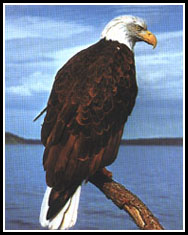 Western Snowy Plover
Western Snowy PloverThe numbers of western snowy plovers recorded on Dungeness NWR during the summer breeding season was 1 in 1978, increasing to 6 in 1986. In June 1995, 4 to 6 were sighted between Graveyard Spit and the lighthouse.
 Bald Eagle
Bald EagleThere are 8 known nesting territories within 10 miles of Dungeness NWR. Many of the nesting pairs are year round residents in the area. In the Northwest, the Bald Eagle often chooses a nesting tree that is obscured by a dense stand of younger trees. The nests are renovated year after year, increasing in size until they break off or the whole tree falls in a storm.
Though the Bald Eagle does eat carrion and occasionally catches crippled waterfowl, its primary diet is fish. Eating contaminated fish and wildlife is a major factor in its now diminished range and numbers for it accumulates the contaminants in its body. Other causes of its decline include hunting, poaching, and diminished habitat.
 Western Snowy Plover
Western Snowy Plover
The numbers of western snowy plovers recorded on Dungeness NWR during the summer breeding season was 1 in 1978, increasing to 6 in 1986. In June 1995, 4 to 6 were sighted between Graveyard Spit and the lighthouse.
The plover uses open, sandy areas for nesting which makes them highly sensitive to disturbance. It is uncertain whether they breed within the refuge, but portions of Graveyard Spit as well as the areas closed to the public at the tip of Dungeness Spit may be suitable for nesting.
 Peregrine Falcon
Peregrine Falcon
While the other birds mentioned here are threatened or sensitive, the Peregrine Falcon is endangered. Sightings are rare but do occur, during spring and fall migrations and during the winter.
The Peregrine Falcon is known for its rapid flight and dramatic swoops after prey and has been highly sought after by falconers as a bird of prey. Pesticide accumulation brought the bird near extinction, but breeding of the bird in captivity is proving successful.
 Harlequin Duck
Harlequin Duck
Though not a federally threatened species, the Harlequin Duck is a Washington state sensitive species. Year round residents of the Dungeness National Wildlife Refuge, they are commonly seen roosting on the Dungeness Bay shoreline from Graveyard Spit northeast to the lighthouse.
They are diving ducks and feed on crustaceans and mollusks. They hide their nests among boulders or grass beneath trees. The young quickly learn to dive and to negotiate rapids and racing waters.
Marbled Murrelet
Another threatened species, the Marbled Murrelet is found fairly frequently in the refuge. This 9½"–10" chubby robin-sized seabird has a very short neck and tail. In summer, the bird is brown above, light brown-and-gray marbled below. In winter, it is black above, and white below with white wing patch and incomplete white collar.
Until fairly recently the nesting habits of this bird remained a mystery. Most birds of its type (alcids) use burrows or ledges on coastal cliffs. The Marbled Murrelet disappears at twilight burdened with fish. Some weeks later, the young are found in the water. It is now understood that they nest inland high in trees, sometimes as far as several miles from the sea.